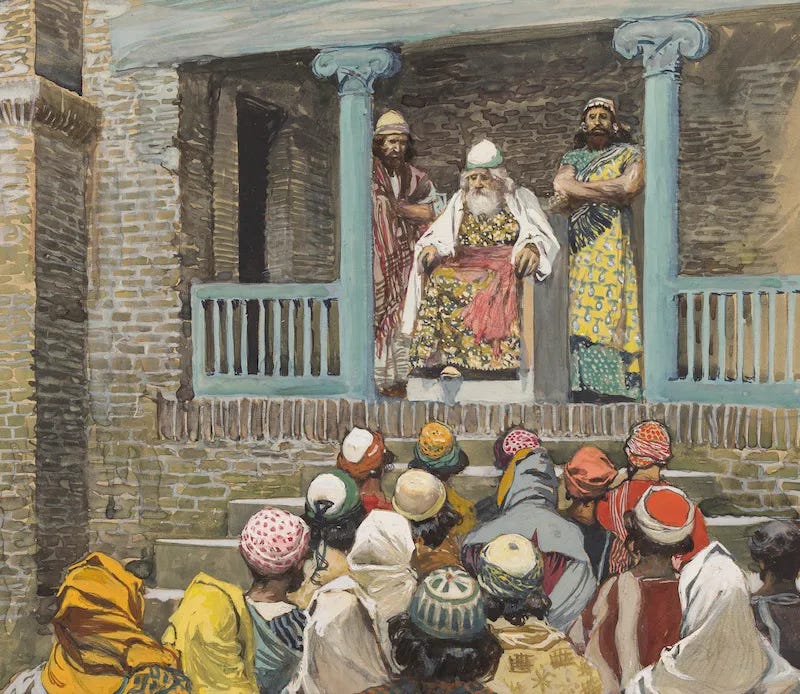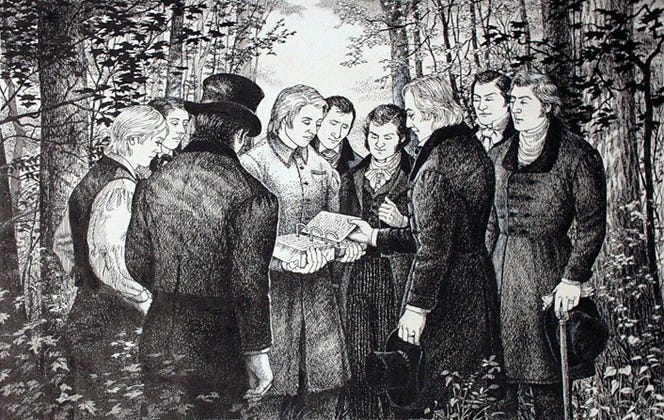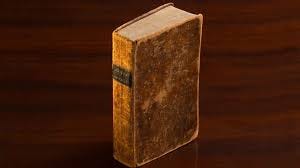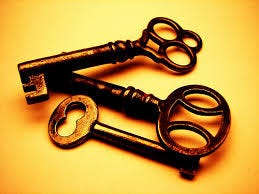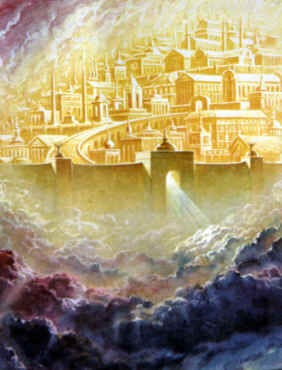What is a prophet? Matthew Bowman’s recent Wayfare essay “The Prophet and the Priest: Joseph Smith's Ecclesiastical Roles” contains interesting information on this topic that may be helpful for thinking about the meaning of terms such as “prophet,” “priest,” and “President of the Church.”
In the previous post we learned that Hiram Page had claimed the status of a prophet by disseminating what he considered to be revelations for the Church that he received from a stone. What were these supposed revelations? According to Susan Easton Black,
About five months before the second conference of the Church in September 1830, Hiram found a stone five-by-three inches in length and one-half inch thick. The stone had two distinct holes. Hiram claimed to receive revelations through this stone. One revelation identified the location of the “America’s New Jerusalem” and another, the proper governing process for the Church.
Daniel C. Peterson sheds more light on the Hiram Page seer stone story,
I share here some notes from Ronald E. Romig, Eighth Witness: The Biography of John Whitmer (Independence, MO: John Whitmer Books, 2014), on a topic that is briefly addressed in the Interpreter Foundation’s forthcoming Witnesses theatrical film:
In August 1830 or shortly before, Hiram Page began to receive revelations through a seer stone. The Whitmer family (into which Hiram Page had married) and Oliver Cowdery (who would marry Elizabeth Ann Whitmer approximately two years later) were inclined to accept them. Unfortunately, no texts survive, though they evidently had something to do with the “upbuilding of Zion,” and perhaps particularly with its organization and its location.
Ezra Booth, who joined the Church of Jesus Christ of Latter-day Saints in May 1831 and had left it by October 1831 to become a vocal critic, described the episode as follows:
Hiram Page, one of the eight witnesses, and also one of the “money diggers,” found a smooth stone, upon which there appeared to be a writing, which when transcribed upon paper, disappeared from the stone, and another impression appeared in its place. This when copied, vanished as the former had done, and so it continued, alternately appearing and disappearing; in the meanwhile, he continued to write, until he had written over considerable paper. It bore most striking marks of a Mormonite revelation, and was received as an authentic document by most of the Mormonites. (79)
In 1856, Emer Harris — Martin Harris’s brother — gave some further details about the incident at a stake conference in Provo, Utah:
Br. Hiram Page dug out of the earth a black stone put it in his pocket when he got home he looked at it it contained a sentence on paper to exce[rpt] it it as soon has [sic] he rote one sentence another sentence came on the stone until he rote 16 pages. (79)
Ron Romig offers an informed speculation and an interesting fact:
This contest of authority could have resulted in a schism before the church was three months old. . . . According to the minutes of this September 26 conference, the church now numbered sixty-two. (81, 82)
So the principle of prophetic leadership vested in the president of the Church had to be established, and it was established very early — in a revelation given in September 1830 and now known as Doctrine and Covenants 28…
…Hiram Page, the Whitmers, and Oliver Cowdery came to accept this; Page’s “revelations” were destroyed and, according to Emer Harris, his seer stone was ground to dust. It’s interesting, though, to read descriptions of how it functioned. Presumably, Joseph’s seer stones worked, or were thought to work, in much the same fashion.
While the mob was raging in Jackson Co. Mo. In 1833 some young men ran down Hiram Page <in the woods> one of the eight <witnesses,> and commenced beating and pounding him with whips and clubs. He begged, but there was no mercy. They said he was <a> damned Mormon, and they meant to beat him to death! But finally one then said to him, if you will deny that damned book, we will let you go. Said he, how can I deny what I know to be true? Then they pounded him again. When they thought he was about to breathe his last, they said to him, Now what do you think of your God, when he dont save you? Well said he, I believe in God—Well, said one of the most intelligent among them, I believe the damned fool will stick to it though we kill him. Let us let him go. But his life was nearly run out. He was confined to his bed for a length of time.3
Susan Easton Black related the following:
In 1833 Hiram was beaten for his religious beliefs. General Moses Wilson wrote of the circumstances that led to his being beaten:
I went in company with forty others, to the house of Hiram Page, a Mormon, in Jackson county. We got logs and broke in every door and window at the same instant, and pointing our rifles at the family, we told them, we would be d—d if we didn’t shoot every one of them, if Page didn’t come out. At that, a tall woman made her appearance, with a child in her arms. I told the boys she was too d—d tall. In a moment the boys stripped her, and found it was Page. I told them to give him a d—d good one. We gave him sixty or seventy blows with hickory withes which we had prepared.2
Although Page later became estranged from the Church, he continued to affirm his testimony of the Book of Mormon:
As was the case with members of the Whitmer family, Page became alienated from Joseph Smith and the main body of the Saints after 1838 and remained in Missouri. However, sources show that he continued to maintain his earlier testimony as one of the Eight Witnesses.
When questioned in 1847 about his earlier testimony of having seen and handled the plates, Page responded, “As to the book of Mormon, it would be doing injustice to myself, and to the work of God of the last days, to say that I could know the same thing to be true in 1830, and know the same thing to be false in 1847. To say that my mind was so treacherous that I had forgotten what I saw.”4
Family members affirmed that he continued to bear faithful testimony until his death. According to his son, Philander Page, “I knew my father to be true and faithful to his testimony of the divinity of the Book of Mormon until the very last. Whenever he had an opportunity to bear his testimony to this effect, he would always do so, and seemed to rejoice exceedingly in having been privileged to see the plates and thus become one of the Eight Witnesses.”5
John Christian Whitmer, a son of Jacob Whitmer, stated, “I was closely associated with Hiram Page in business transactions and other matters, he being married to my aunt. I knew him at all times and under all circumstances to be true to his testimony concerning the divinity of the Book of Mormon.”6
Susan Easton Black recorded the rest of Page’s testimony:
As to the book of Mormon, it would be doing injustice to myself, and to the work of God in the last days, to say that I could know a thing to be true in 1830, and know the same thing to be false in 1847. To say that a man of Joseph’s ability, who at that time did not know how to pronounce the word Nephi, could write a book of six hundred pages, as correct as the book of Mormon, without super natural power . . . yeah, it would be treating the God of heaven with contempt to deny these testimonies, with too many others to mention here.5
This is another interesting account of the Hiram Page seer stone story:
In September 1830, Hiram Page unearthed a black stone, which he then began using as a seer stone to receive revelations for the Church of Christ. Page “looked at [the stone]. It contained a sentence on paper to befit it. As soon as he wrote one sentence, another sentence came on the stone, until he wrote 16 pages.” Oliver Cowdery and the Whitmer family believed that the revelations received from the stone (probably about church government and the location of Zion) were direct communications from God. These revelations challenged Joseph Smith’s exclusive authority. Troubled, Smith prayed and received revelation regarding this stone, now canonized as Doctrine and Covenants Section 28. Smith declared the stone to be an actual, supernatural seer stone that was consecrated for use by the devil and any revelations received from it were given by the devil. Page was convinced to destroy both the stone and the revelations. The stone was ground to powder and all the revelations burned.
The events of this story established the doctrine that only the Prophet could receive revelations for the whole church, and that any communication from God out of harmony with the prophets was from the Deceiver. From this point onward Joseph Smith secured his place as the sole revelator for the entire church.
If Hiram Page wrote 16 pages about Church government and the location of Zion, even this false revelation indicates that the early Saints were eager to learn more about such topics. It is also more evidence that these early Saints were sincere in their beliefs. (see also here)
In Doctrine and Covenants 28, therefore, the Lord revealed that Joseph Smith held the keys of the mysteries, and that only he received revelations for the Church. The Lord also called Oliver Cowdery to preach the Gospel to the Lamanites, and the Lord revealed that Satan had deceived Hiram Page by giving him false revelations.
In the first part of D&C 28, the Lord established His order for revelation in the Church:
Behold, I say unto thee, Oliver, that it shall be given unto thee that thou shalt be heard by the church in all things whatsoever thou shalt teach them by the Comforter, concerning the revelations and commandments which I have given.
But, behold, verily, verily, I say unto thee, no one shall be appointed to receive commandments and revelations in this church excepting my servant Joseph Smith, Jun., for he receiveth them even as Moses.
And thou shalt be obedient unto the things which I shall give unto him, even as Aaron, to declare faithfully the commandments and the revelations, with power and authority unto the church.
And if thou art led at any time by the Comforter to speak or teach, or at all times by the way of commandment unto the church, thou mayest do it.
But thou shalt not write by way of commandment, but by wisdom;
And thou shalt not command him who is at thy head, and at the head of the church;
For I have given him the keys of the mysteries, and the revelations which are sealed, until I shall appoint unto them another in his stead. (D&C 28:1-7)
Joseph Smith was a modern Moses, and Oliver Cowdery was a modern Aaron. Oliver was still the spokesman for Joseph and the first preacher of the Church, but he was not the head or president of the Church. Under the Lord’s direction, Joseph Smith was the prophet and leader of the Church who held all of the keys, including the keys of the mysteries, and the revelations which are sealed. What are the keys of the mysteries, and the revelations which are sealed?
And this greater priesthood administereth the gospel and holdeth the key of the mysteries of the kingdom, even the key of the knowledge of God. (D&C 84:19)
And the keys of the mysteries of the kingdom shall not be taken from my servant Joseph Smith, Jun., through the means I have appointed, while he liveth, inasmuch as he obeyeth mine ordinances. (D&C 64:5)
And I have given unto him the keys of the mystery of those things which have been sealed, even things which were from the foundation of the world, and the things which shall come from this time until the time of my coming, if he abide in me, and if not, another will I plant in his stead. (D&C 35:18)
Joseph Smith held these keys, and I wonder where they are now?
It is significant that the Lord promised that Joseph Smith would hold the keys until He, the Lord, appointed another in his stead, or that if Joseph Smith were unfaithful, the Lord would plant another in his stead. As far as I can tell, Joseph Smith was true and faithful, and he even laid down his life in the cause of Christ. The history of prophetic succession in the Church is a topic that I hope to explore more in depth throughout our study of the Doctrine and Covenants this year.
It is clear from the foregoing verses that although Oliver was authorized to teach by the Comforter the commandments and the revelations that had already been given, but that only Joseph Smith could receive new commandments and revelations for the entire Church. Furthermore, the Lord enabled the Prophet Joseph Smith to receive new commandments and revelations for the entire Church through the keys of the mysteries of the Kingdom, or in other words, the key of the knowledge of God. These revelations concerning keys of knowledge remind me of the title of one of my favorite books, Parley P. Pratt’s The Key to the Science of Theology.
Smith and Sjodahl’s contribute the following commentary to the aforementioned verses:
The spirit of persecution being rampant in the City of Harmony, Pa., the Prophet Joseph moved to Fayette, N.Y., to Mr. Whitmer’s house. On arriving there, he learned that Hiram Page had obtained a stone by means of which, as he thought, he received revelations concerning the upbuilding of Zion and the government of the Church, and that Oliver Cowdery, the Whitmers, and others were inclined to accept those revelations as the word of God. The Prophet felt concerned about the matter, for he perceived the cunning of the adversary. In answer to his earnest prayers, the Lord gave this Revelation, addressed especially to Oliver Cowdery, in which He (1) reveals fully the great principle that divine revelations come only through the regular channels; (2) appoints Oliver Cowdery a missionary to the Lamanites; (3) instructs him to obey counsel, and (4) to set Hiram Page right before leaving on his mission: and (5) assures him of divine guidance in the service of the master.
Thou shalt be heard by the church] Oliver Cowdery was one of the six original members of the Church and a special witness to the divinity of the work. He held the Melchizedek Priesthood, and had every claim to a hearing by the Church, but only as he, in his utterances, was guided by the Spirit. His calling was to teach the truths already revealed.
No one shall be appointed to receive commandments *** excepting my servant Joseph] When the Lord had a new commandment to give, or a new revelation to make, He would do so through him who had been appointed for that purpose (Comp. Sec. 5:2). God always honors and sustains His servants in their various positions, as He did when He directed Cornelius to send for Peter, to whom the preaching of the gospel had been entrusted (Acts 10:32).
Thou shalt be obedient] To the voice of God. When the bugle sounds, those concerned govern themselves accordingly because a higher will than that of the bugler is heard in the call.
Oliver Cowdery might speak and teach, and even command, as long as he confined himself to the Revelations God had given, (v. 3); he might write as a wise counselor (v. 5) but, not as having authority, and he could not issue commands to the Prophet whom God had placed at the head of the Church, under His Son, our Redeemer (v. 6). It is the git of the Prophet to declare mysteries and truths not known (v. 7).
Mysteries] A mystery is a truth that cannot be known except through divine revelation - a sacred secret. In the days of Paul the important truth that Gentiles were to be admitted to the Kingdom of God without observing the Law of Moses was a “mystery” (Eph. 1:9-11; Col. 1:25-27). In our day such great truths as those pertaining to the restoration of the Priesthood, the work for the dead, and the re-establishment of the Church are “mysteries,” because they could not have been discovered except by revelation.
It should be noted that when God revealed a truth to anyone, through the Prophet Joseph, President Brigham Young, or any of their successors, that truth was just as true, and just as binding, as if Peter, James, John, Gabriel, or Michael had been sent with the message. He who does not believe the word of God through a mortal messenger, would not believe one from the other side of mortality (Luke 16:31). (pp. 140-41)
The truth of this last comment by Smith and Sjodahl depends, of course, upon the facts concerning prophetic succession, or in other words, it depends upon the facts concerning whom the Lord appointed in the stead of Joseph Smith to hold the keys of the mysteries of the Kingdom.
The Lord then called Oliver Cowdery to serve as a missionary to the Lamanites:
And now, behold, I say unto you that you shall go unto the Lamanites and preach my gospel unto them; and inasmuch as they receive thy teachings thou shalt cause my church to be established among them; and thou shalt have revelations, but write them not by way of commandment. (D&C 28:8)
Smith and Sjodahl expound upon this verse as follows:
You shall go unto the Lamanites] Oliver Cowdery was the first one called to go on a mission among the American Indians. This mission had a two-fold purpose: One was to establish the Church among the Lamanites; another, to call the attention of the Saints to the place where the New Jerusalem, the City of Zion, should be built. (p. 142)
It appears that one of the false revelations that Hiram Page received had something to do with the location of the city of Zion or the New Jerusalem. I wonder where Hiram Page and those who believed his false revelations though that the city would be located? Wherever they thought it might be, the Lord corrected them and informed them that He had not yet revealed the location of the city of Zion, but that He would reveal it later:
And now, behold, I say unto you that it is not revealed, and no man knoweth where the city Zion shall be built, but it shall be given hereafter. Behold, I say unto you that it shall be on the borders by the Lamanites. (D&C 28:9)
Smith and Sjodahl add:
No man knoweth where the city shall be built] It is not improbable that some of the pseudo-revelations of Hiram Page related to this very subject. The Saints were full of enthusiasm, looking for the immediate fulfillment of the prophecies. The Lord now made it known that the locality of that holy city had not yet been revealed, but that it might be looked for “on the borders by the Lamanites.” Further revelation on this subject would come later (Sec. 57:2, 3).
The Lord commanded Oliver Cowdery to wait until after the Church conference to embark upon his mission:
Thou shalt not leave this place until after the conference; and my servant Joseph shall be appointed to preside over the conference by the voice of it, and what he saith to thee thou shalt tell. (D&C 28:10)
The Lord also commanded Oliver Cowdery to privately correct and instruct his brother in the Gospel, Hiram Page, about his purported revelations before embarking upon his mission to the Lamanites:
And again, thou shalt take thy brother, Hiram Page, between him and thee alone, and tell him that those things which he hath written from that stone are not of me and that Satan deceiveth him;
For, behold, these things have not been appointed unto him, neither shall anything be appointed unto any of this church contrary to the church covenants.
For all things must be done in order, and by common consent in the church, by the prayer of faith.
And thou shalt assist to settle all these things, according to the covenants of the church, before thou shalt take thy journey among the Lamanites. (D&C 28:11-14)
These revelations make sense. The Lord’s way of doing things is infinitely superior to the ways of men. How gently and charitably the Lord taught and corrected his servants Oliver and Hiram. The Lord knew that His new Saints had just begun to learn about revelation and His higher ways, and He gently guided them out of error into the truth. Order, common consent, and the prayer of faith are the Lord’s ways in His Church.
Smith and Sjodahl add:
Conference] The second Conference of the Church which convened September 26th, 1830 (Sec. 26:1).
Thou shalt take thy brother, Hiram Page, etc.] The Lord, having revealed the error of Hiram Page in the matter of the “seer-stone,” directed Oliver Cowdery to labor with him and show him, in all kindness, that he was being deceived by the Evil one.
13. Common consent] See Section 26:2)
14. Settle all these things] Oliver Cowdery could not go on his important mission to the Lamanites, until he had settled this difficulty. When the Church is weakened by schisms, missionary efforts cannot have the same success as when unity and harmony prevail. The strength of an army in the field depends largely on the conditions at the bases of supply. It is so with the missionary forces of the Church. (pp. 142-42)
The revelation in D&C 28 concludes:
And it shall be given thee from the time thou shalt go, until the time thou shalt return, what thou shalt do.
And thou must open thy mouth at all times, declaring my gospel with the sound of rejoicing. Amen. (D&C 28:15-16)
Smith and Sjodahl add:
When a missionary goes out into the world, in obedience to a divine call, being in full fellowship with the Church, and leaving no unsettled incidents behind, he may rely on the Lord for protection and guidance.
Rejoicing] The gospel should be preached with joy, and not as a message of sorrow or gloom. The labors of a missionary should not be a hard but a pleasant duty. (p. 143)
General Notes
The case of Hiram Page was submitted to the Conference and settled in accordance with this Revelation.
In Acts (chap. 15) we have a remarkable record of difficulty in the early church, which also was settled in a general conference. Some of the brethren taught, in opposition to Paul and Barnabas, that Gentile concerts were under the necessity of being circumcised before joining the Church. The question was laid before a conference at Jerusalem, and, after some discussion, Peter moved that it be the sense of the Conference (if a modern expression be permitted) that both Jews and Gentiles are saved “by the grace of Christ); that is, by the gospel. James seconded this motion and added the suggestion that the decision of the Conference be embodied in a letter to the Gentile churches. This was adopted, but the schism had threatened the Church for years.
The question of the proper channels of revelation was fully settled in the Conference at Fayette, September 26th, 1830.
Hiram Page was born in the year 1800, and, when a young man, traveled considerably as a physician. He joined the Church on the 11th of April, 1830, and became one of the Eight Witnesses to the Book of Mormon. In due time he removed to Independence, Mo., and later became one of the pioneers of the City of Far West. In 1838, however, he drifted away from the Church. He never rescinded his testimony. He died on the 12th of August, 1852.
The doctrine revealed in this Revelation (1-7) was well known to the former-day Saints. In the Patriarchal dispensation on one could take the place of the Patriarch. In the Mosaic dispensation no one could take the position of Moses (See, for instance, Numb. chap. 16). Aaron was the spokesman; Moses was to him “instead of God” (Ex. 4:14-16)
The Lamanite mission was a very important movement of th eyoung but vigorous Church. Oliver Cowdery was the first-appointed member of the party. Peter Whitmer, Jr., was added by Revelation (Sec. 30); and then Parley P. Pratt and Ziba Peterson (Sec. 32). Soon after the Conference the little party set out on the perilous journey of about 1,500 miles. They started on foot, trusting in the Lord to open the way. Near Buffalo they visited the Catteraugus Indians and left the Book of Mormon with them. Then they proceeded to Kirtland, Ohio. Here they visited Sidney Rigdon, then a popular Campbellite minister. He and some of his friends joined the Church. Night and day, for some time, the missionaries were teaching the people in Kirtland and vicinity. After having ordained Rigdon, Isaac Morley, John Murdock, Lyman Wight and others, to the ministry, the missionaries left for the West. Near Sandusky they visited the Wyandot tribe and preached the gospel. In Cincinnati and St. Louis they met with very little success. At the latter place their progress was impeded by heavy snowstorms. With the opening of the New Year, 1831, they continued their journey, traveling on foot 300 miles over prairies, without shelter and fire, living on frozen corn, bread and raw pork. At length they reached Independence, Mo., on the extreme western frontier of the State. They had traveled four months and suffered untold hardships; they had preached to two Indian nations and to thousands of white people, and organized several strong branches of the Church.
After having rested a little at Independence, three of the brethren crossed the frontier and visited the Shawnee Indians. Then they went among the Delawares. These manifested a great deal of interest in the Book of Mormon. Therefore the jealousy of ministers was aroused and these prevailed upon the Indian agents to expel the missionaries from the Indian country. They, accordingly, returned to Jackson county, where they labored for some time with encouraging success. (pp. 143-44)
The note in the Come Follow Me manual on this section is instructive:
Why was a mission to the Lamanites significant?
One purpose of the Book of Mormon is “that the Lamanites might come to the knowledge of their fathers, and that they might know the promises of the Lord” (Doctrine and Covenants 3:20). This was consistent with promises the Lord made to many Book of Mormon prophets (see, for example, 1 Nephi 13:34–41; Enos 1:11–18; Helaman 15:12–13). Early Church members considered the American Indians to be descendants of the Book of Mormon people. (The official position of the Church today is that the Lamanites “are among the ancestors of the American Indians” [introduction to the Book of Mormon].)
To read more about Oliver Cowdery’s mission to nearby American Indians, see, “A Mission to the Lamanites,” Revelations in Context, 45–49. What does this mission teach you about the Lord and His work?
Oliver was to be to Joseph as Aaron was to Moses, serving as a teacher and spokesman. His first assignment in that role was to convince Hiram Page of his error concerning the revelations from his stone. Second, he was to undertake a mission to the American Indians.9
When the conference convened in late September, Joseph Smith’s retrospective history records, “The subject of the stone above mentioned, was discussed, and after considerable investigation, Brother Page, as well as the whole church who were present, renounced the said stone, and all things connected therewith, much to our mutual satisfaction and happiness.”10 Oliver Cowdery’s brief minutes record that Joseph Smith “was appointd by the voice of the Conference to receive and write Revelations & Commandments for this Church.”11
Joseph frequently received revelations and commandments, but most of them remained unpublished for several years, limiting their availability among Church members. At the same time, the Church’s missionary efforts produced a large number of new proselytes. Many members either were unaware of, misunderstood, or chose to disregard the revelations that clarified Joseph Smith’s role, and spurious claims to revelation for the Church continued on occasion.
Not long after the Church’s relocation to Kirtland, Ohio, a “woman by the name of Hubble” came forward claiming her own revelations.12 Once again, a revelation (now known as Doctrine and Covenants 43) confirmed that Joseph was the one “appointed unto you to receive commandments & Revelations from my hand” and added “that none else shall be appointed unto this gift except it be through him.”13
The Saints’ doctrine of renewed, New Testament–like manifestations of the Holy Ghost invited members to seek the gift of revelation for themselves. For the Church as a whole, however, the developing structure and practice designated Joseph Smith’s as the lone voice of authority to pronounce revelation that would be binding on all Church members. “For,” as the September 1830 revelation told Oliver Cowdery, “all things must be done in order.”14





